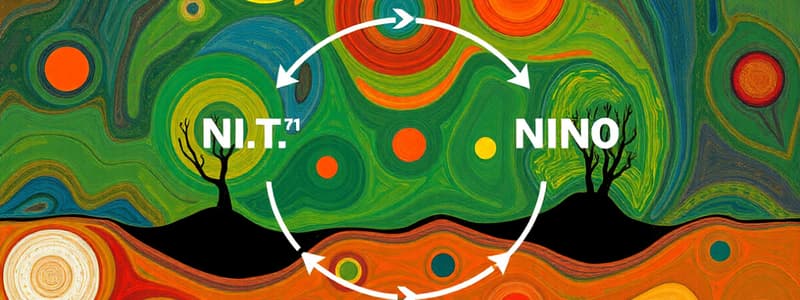Podcast
Questions and Answers
Which of the following would be the LEAST likely consequence of increased fixed nitrogen cycling due to human activity?
Which of the following would be the LEAST likely consequence of increased fixed nitrogen cycling due to human activity?
- Decreased atmospheric concentrations of greenhouse gases. (correct)
- Eutrophication of aquatic ecosystems.
- Increased emissions of nitrous oxide from agricultural soils.
- Increased primary productivity in terrestrial ecosystems.
What is the approximate percentage of oxygen found in clean, dry air at Earth's surface?
What is the approximate percentage of oxygen found in clean, dry air at Earth's surface?
- 0.93%
- 20.94% (correct)
- 78.08%
- 0.03%
Which statement best describes the El Niño Southern Oscillation (ENSO)'s influence on global ecological systems?
Which statement best describes the El Niño Southern Oscillation (ENSO)'s influence on global ecological systems?
- ENSO solely impacts marine ecosystems along the equator.
- ENSO is a large-scale phenomenon that can cause widespread changes in temperature and precipitation patterns, affecting both marine and terrestrial ecosystems globally. (correct)
- ENSO is an atmospheric phenomenon that primarily affects terrestrial ecosystems.
- ENSO is a localized weather pattern with minimal global ecological consequences.
How does rapid change in global patterns of land use most significantly threaten biological diversity?
How does rapid change in global patterns of land use most significantly threaten biological diversity?
What is the approximate percentage of nitrogen found in clean, dry air at the Earth's surface?
What is the approximate percentage of nitrogen found in clean, dry air at the Earth's surface?
Flashcards
El Niño Southern Oscillation (ENSO)
El Niño Southern Oscillation (ENSO)
A large-scale atmospheric and oceanic phenomenon that influences ecological systems globally.
Human Impact on Nitrogen Cycle
Human Impact on Nitrogen Cycle
Human activities have significantly increased the amount of nitrogen cycling in the biosphere.
Land Use Change Impact
Land Use Change Impact
Changes driven by humans in how land is used pose a threat to the diversity of plant and wildlife.
Atmospheric Composition Change
Atmospheric Composition Change
Signup and view all the flashcards
Composition of Air
Composition of Air
Signup and view all the flashcards
Study Notes
- Chapter 23 discusses global ecology, covering various concepts and applications that affect ecological systems on a global scale
The El Niño Southern Oscillation (ENSO)
- A large-scale atmospheric and oceanic phenomenon that influences ecological systems globally
Human Impact on Nitrogen Cycling
- Human activity has significantly increased the amount of nitrogen cycling through the biosphere
Land Use and Biological Diversity
- Rapid changes in global land use patterns pose threats to biological diversity
Atmospheric Composition
- Human activities are altering what the atmosphere is made up of
Atmospheric Composition
- Clean, dry air at Earth's surface contains about 78.08% nitrogen, 20.94% oxygen, 0.93% argon, and 0.03% carbon dioxide, with trace amounts of ozone, helium, hydrogen, krypton, methane, and neon
Atmospheric Layers
- The highest concentrations of atmospheric gases are in the troposphere, which extends 9 to 16 km above Earth
- The stratosphere, which extends to an altitude of 50 km, contains most of the ozone that shields Earth from UV light
- Above the troposphere, the mesosphere and the thermosphere are found
Greenhouse Effect
- The atmosphere keeps Earth's surface warm through the greenhouse effect
- Greenhouse gases include water vapor, CO2, methane,ozone, nitrous oxide, and CFCs trap heat
- Gases absorb infrared radiation and re-emit most back to Earth
- The atmosphere/surface absorbs 70% of incoming solar energy, while 30% is reflected by clouds and particles
Climate Change and Ecosystems
- It is important to study patterns across multiple taxa over long periods
- Menzel et al. used 100,000 time series records to study plant phenological shifts
- Parmesan and Yohe (2003) analyzed many studies
- They found significant, nonrandom patterns of change following climate records across >1,700 taxonomic groups
The El Niño Southern Oscillation (ENSO)
- Definition: A large-scale atmospheric and oceanic phenomenon that influences ecological systems globally
- During ENSO, a warm water current forms by Peru, usually during Christmas, and El Niño refers to the Christ child
- The Southern Oscillation refers to pressure changes across the Pacific Ocean
Historical Context
- Walker (1924) found a relationship between barometric pressure across the Pacific and rainfall during monsoons
- Barometric pressure rising in the western Pacific causes a decrease in pressure in the eastern Pacific, and vice versa, known as the Southern Oscillation
- ENSO is associated with droughts in Australia, India, Indonesia, and parts of Africa
- Winter temperatures in Canada are supposedly connected to the Southern Oscillation
El Niño and Southern Oscillation Connection
- Bjerknes linked El Niño water temperatures to the Southern Oscillation
- A gradient in sea surface temperatures over the central Pacific triggers atmospheric circulation
- Air mass flows westward accumulating moisture as it warms
- Then combines with rising air in the western Pacific
Dynamics of ENSO
- ENSO is a dynamic, large-scale system that drives global climatic variability
- The eastern tropical Pacific sea surface becomes much warmer than average during its mature phase
- The barometric pressure is lower than average
- Promotes storm formation and increases pricipitation to North and South America
El Niño and La Niña
- During El Niño, sea surface temperatures in the western Pacific are cooler than average, and barometric pressure is higher than average, causing drought over the western Pacific
- La Niña: Characterized by lower sea surface temperatures and higher than average pressure in the tropical Pacific
- It brings drought to much of North America and higher than average precipitation in the western Pacific
ENSO Marine Population
- Coastal waters by the coast of South America are relatively cool
- Cool water is brought to the surface by upwelling
- During El Niño, that warm water has now shut off that upwelling
- Nutrient supply and phytoplankton production declines
- Decreases food availability for consumers and causes the food web to decline in fish population
El Niño
- A strong El Niño in 1982-83 caused storms deep into the interior of North America.
- High precipitation in the Great Salt Lake basin.
- The lake rose 3.7 m between 1983 and 1987.
- Lake salinity dropped by 50 g/L, allowing the predaceous insect Trichocorixa verticalis to invade.
- Induced a trophic cascade with increased phytoplankton biomass.
- Lake level returned to normal by 1990, reversing these changes.
El Niño and La Niña: Australia
- El Niño effects in Australia: drought, while La Niña events bring heavy rainfall.
- Associated with perennial plants
- New narrow-leaf hopbush cohorts are made during La Niña
- Plant community structure in Australia is affected by ENSO weather pattern
El Niño: Kangaroo
- Red kangaroos (Macropus rufus) are found in Australia's semiarid interior.
- Wet years, allow females to be reproductive at different stages
- Marginal conditions: Young will die after leaving the pouch
- Because a lack of food will cause the females to stop lactating
Kangaroo Reproduction
- Prolonged droughts during El Nino, causes Red kangaroos to stop breeding
- 60 days after significant rainfall they breed quickly
- Increase offspring when weather is good, helps later through El Nino induced droughts
Human Impact on Nitrogen Cycle
- Humans began to have a massive influence through industrial agriculture
- Natural Nitrogen Levels: N-Fixing Bacteria/Plants: 100 Tg/yr, Marine: 5 to 20 Tg/yr, Lightning: 10 Tg/yr and total Natural: 130 Tg/yr
- Human Nitrogen Levels: 135 to 145 Tg/yr
Tropical Deforestation
- Tropical forests are home to at least half of the Earths species
- Tropical forests occupy 73 countries and once occupied 11,610,360 km²
- Brazil, in 1998, covered 1/3 of total and Brazil has the highest deforestation rate
- 230,000 km² had been deforested, peak deforestation in 2004 was 27,000 km²
Effects of Deforestation
- Forest fragmentation has edge effects
- Isolated, edge fragments are exposed to solar radiation and wind exposure
- Fragments change their physical environment
- There is hotter higher, drier, solar intensity
- Animal group diversity decreased
Deforestation: Global
- A global loss of 76,000 km² of tropical forest happens annually in the 2000s
- Massive deforestation occurs in temperate and boreal regions as well
- Human activity has changed half the ice-free land cover of earth
- Many terrestrial biomes are highly fragmented, some nearly eliminated
- Potential to contribute to global climate change from deforestation as well
Atmospheric CO2 Composition
- Records extracted from ice cores in Greenland and Iceland
- Ice samples contained trapped atmosphere
- Antarctic ice cores contain record of last 800,000 years of atmospheric CO2
- There is a overall oscillation between 170 and 300 ppm
Atmospheric Composition
- Low CO2 levels match up with low temperatures for ice ages
- Higher CO2 happened during interglacial periods
- In the 1800 and 1900 atmospheric CO2 increased dramatically
Fossil Fuels
- 5,600 Tg/yr of Carbon released from burning fossil fuels
- In the atmosphere, a change of 3,500 Tg/yr in annual Carbon
- World War I, Great Depression, and World War II, all interrupted three major periods of increases in atmospheric CO2
Ozone
- 1985 British surveyed reduction in atmospheric ozone in arctic
- Attention switched to stopping chlorofluorocarbons (CFCs)
- 1987 Montreal Protocol happened
- Hole reached max area in 2000
- 2003 layer started recovering
Studying That Suits You
Use AI to generate personalized quizzes and flashcards to suit your learning preferences.




